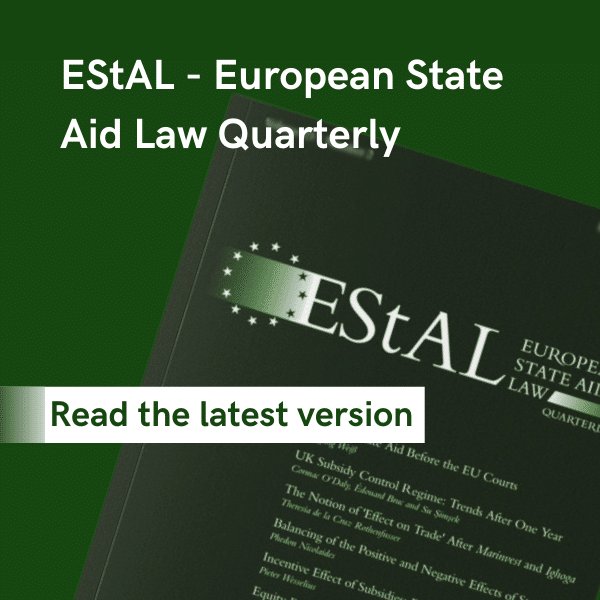
A measure is imputable to the state whenever the state is involved in its adoption or shapes the decision that leads to its adoption.
Introduction
One of the trickiest aspects of determining whether a financial transaction involves State aid is its attribution or imputation to a decision of the state, especially when the entity providing the funding is private.
Private entities do not grant State aid because, by definition, State aid is a gratuitous benefit which is given without anything in return, a “quid” without “quo”. Private entities are presumed to act rationally and in their self-interest in always expecting a payoff of at least equivalent value in return to the funding they provide [this is also the reason why a private entity that gives away something for nothing would be classified as a non-undertaking].
Yet, in a rather unusual case, the Court of Justice ruled on 2 March 2021 that the rescue of an Italian bank by a private banking consortium, in a situation where, in my view, no other private investor appeared to be willing to commit a similar amount of money, did not involve State aid. The Commission had attributed that financial transaction to the Italian state and considered that it did constitute State aid. Italy disagreed on the grounds that the transaction was not mandated by the state. It was decided unilaterally by the consortium. On appeal, both the General Court and the Court of Justice agreed with Italy.
The Court of Justice delivered its judgment in case C‑425/19 P, Commission v Italy.[1] The Commission had appealed against the judgment of 19 March 2019 of the General Court in case T‑98/16, Italy v Commission. Italy sought annulment of Commission decision 2016/1208 [of 23 December 2015] which ordered Italy to recover incompatible State aid from Banca Tercas that had been taken over by Banca Popolare di Bari [BPB]. The judgment of the General Court was reviewed here on 9 April 2019
https://www.lexxion.eu/en/stateaidpost/the-boundary-between-state-and-private-resources/
Under Italian law, banks may choose to insure deposits up to EUR 100,000 [the so-called “covered” deposits] with private deposit guarantee schemes. The protection of covered deposits is required by EU Directive 94/19.
The Fondo interbancario di tutela dei depositi [FITD] is a consortium of banks governed by private law which is established for the purpose of guaranteeing its members’ deposits. In the event of the compulsory liquidation of one of its members, the FITD repays deposits up to a maximum of EUR 100,000 per depositor. This is the so-called “mandatory intervention”. The FITD also has power to intervene for the benefit of its members on a voluntary basis; the so-called “voluntary interventions”.
In 2011-12, Banca Tercas entered into financial difficulties. It experienced internal irregularities and its equity turned negative. In April 2012, the Bank of Italy placed Banca Tercas under special administration. In May 2014, FITD decided to provide three tranches of funding to Tercas for the following purposes: (i) EUR 265 million to cover Tercas’ negative equity, (ii) a guarantee of EUR 35 million to cover the credit risk associated with certain exposures of Tercas, and (iii) a guarantee of EUR 30 million to cover the costs arising from the tax treatment of the first measure.
All the shares of Banca Tercas were cancelled and new shares were issued for the benefit of BPB. In October 2014, Tercas left special administration and a new management was appointed by BPB. Apparently, FITD received no shares. Therefore, it provided the funding to Banca Tercas only because the cost of compensating the covered depositors was larger than the amount of that funding. As the Court of Justice described it in the text of its judgment, FITD took this decision “(18) in view of the cost of the measures in question compared with the cost of compensation under the mandatory intervention”. Therefore, FITD acted “rationally” to minimise its losses, but only because it was mandated by law to save covered depositors.
After a formal investigation, in December 2015 the Commission adopted decision 2016/1208 by which it found that the funding from FITD constituted incompatible aid and, consequently, it ordered its recovery. However, on appeal by Italy, the General Court annulled the Commission decision on the grounds that the Commission failed to prove that the decision of FITD was attributed or imputed to the Italian state.
The judgment of the Court of Justice
Did the General Court set an unusually high standard of proof?
The Commission’s first plea was that the General Court applied a very high standard of proof with respect to the attribution to the state of the measure in question.
The Court of Justice, first, recalled the relevant principles. “(58) As regards the existence of an intervention by the State or through State resources, which is the only condition at issue in the present case, it should be borne in mind that, in order for it to be possible to classify advantages as ‘aid’ within the meaning of Article 107(1) TFEU, they must be granted directly or indirectly through State resources and be imputable to the State”.
“(59) Concerning specifically the imputability to the State of a measure, the Court has held that this may not be inferred from the mere fact that the measure was taken by a public undertaking. Even if the State is in a position to control a public undertaking and to exercise a dominant influence over its operations, actual exercise of that control in a particular case cannot be automatically presumed. It is also necessary to examine whether the public authorities must be regarded as having been involved, in one way or another, in the adoption of the measure in question”. Please note that the Court refers in this paragraph to the situation where the aid is provided by a “public undertaking”, an undertaking that is owned or controlled by the state.
“(60) Thus, the imputability to the State of an aid measure taken by a public undertaking may be inferred from a set of indicators arising from the circumstances of the case and the context in which that measure was taken. In that regard it cannot be demanded that it be demonstrated, on the basis of a precise instruction, that the public authorities specifically incited the public undertaking to take the measure in question”.
“(61) Specifically, any indication, in the particular case, either, on the one hand, of the involvement by the public authorities in the adoption of a measure or the unlikelihood of their not being involved, having regard also to the compass of the measure, its content or the conditions which it contains, or, on the other hand, the absence of those authorities’ involvement in the adoption of that measure is relevant”.
“(62) Evidence supporting the conclusion that the measure is imputable to the State includes, in addition, the fact that the public undertaking in question could not have taken the decision at issue without taking account of the requirements of the public authorities or the directives emanating from the public authorities, the integration of the public undertaking into the structures of the public administration, the nature of its activities and the exercise of those activities on the market in normal conditions of competition with private operators, the legal status of the undertaking as well as the intensity of the supervision exercised by the public authorities”.
Then the Court applied the principles above to the case at hand and specially to the issue of imputability. The problem with this approach of the Court is that the previous cases it cited referred to entities which were either controlled by the state or belonged to the state. Yet the status of FITD was different. It was 100% private. The Court should have developed new criteria. For example, the Court should have asked how FITD would have behaved if it were not required by law to compensate covered depositors. After all, the Court referred to the “unlikelihood” of state involvement, which implied some sort of counterfactual. What was the counterfactual in this situation? Would the funding provided to Banca Tercas be financially rational if FITD did not have to compensate covered depositors? [No.] And was the outcome of the funding equivalent to protecting depositors? [Yes, because it kept Banca Tercas alive.]
The Court of Justice noted “(65) in the first place, [that] […] the General Court pointed out, […] that, even in a situation where aid is granted by a public undertaking, the exercise of the public authorities’ control cannot be presumed and that the Commission must have a set of indicators arising from the circumstances of the case and the context in which the financial assistance was given in order to establish the degree of involvement by the public authorities in granting the aid through the intermediary of a public undertaking.”
“(66) The General Court found, […] that the ‘obligation of the Commission’ to have such evidence ‘is all the more necessary’ in a situation where the measure under examination is taken by a private entity […], the Commission cannot rely on the existence of links of a capital nature between such an entity and the State, since such links are missing in a situation of that type.”
“(67) It is in the light of those considerations that the General Court held, […] that the Commission could not, in the present case, rely on the unlikelihood of an absence of actual influence and control by the public authorities over the private entity providing the aid, but that, on the contrary, in such a situation there was an even more stringent requirement for the Commission to set out and substantiate ‘sufficient evidence’ capable of establishing that the aid measure under consideration had been adopted under the actual influence or control of the public authorities and that, accordingly, that measure is imputable to the State.”
Indeed, in the case of entities which are not controlled by the state, it is even more important to show how their decisions are actually influenced by the state. But this line of reasoning misses an essential component – that the state can exert influence indirectly by making the alternative option more costly. FITD provided funding because the alternative option – the compensation of covered deposits – was more costly. The state did not have to dictate or shape that decision as long as the outcome was equivalent to protecting depositors.
At any rate, the Court of Justice went on to endorse the approach of the General Court. “(69) The General Court neither failed to have regard to the case-law […], according to which it is for the Commission to demonstrate, on the basis of a set of indicators, that the measures at issue were imputable to the State, nor, therefore, did it require the Commission to meet a higher standard of proof solely on account of the fact that the FITD is a private entity.”
“(70) The General Court limited itself to taking note, […] of the objective differences between a situation where the entity providing the aid is a public undertaking and that in which, as in the present case, that entity, namely the FITD, is a private entity.”
“(72) Thus, contrary to the Commission’s assertions, in a situation where, as in the present case, the entity that provided the aid is a private entity, the appropriate evidence for the purpose of demonstrating that the measure is imputable to the State differs from that required in a situation where the entity providing the aid is a public undertaking.”
The Court of Justice did not specify what the appropriate evidence was in the case of private entities and how it differed from that in the case of public entities. The General Court, in paragraphs 90 and 91 of its judgment, referred to “evidence to demonstrate that that measure had been adopted under the actual influence or control of the public authorities” and to “the degree of intervention by the public authority in the definition of the measures in question”. These are the standard criteria of imputability but, as argued above, they are not appropriate in this case.
Nonetheless, the Court of Justice agreed with the General Court that “(73) in so doing, the General Court did not impose different standards of proof but, rather, applied the case-law […], according to which the appropriate evidence for the purpose of demonstrating the imputability of an aid measure arises from the circumstances of the case and the context in which that measure was taken, and the absence of a link of a capital nature between the entity concerned and the State is clearly relevant in that regard.”
Full analysis?
The Commission also argued that the General Court failed to carry out an overall analysis of the evidence produced by the Commission in order to demonstrate that the measures adopted by the FITD were imputable to the Italian State. The Court of Justice rejected this argument too.
“(82) In examining the scope of the public mandate conferred on the FITD, the General Court, […] analysed all of the evidence produced by the Commission in that respect. It is only after that analysis that the General Court concluded, […] that a voluntary intervention of the FITD, such as that at issue in the present case, in that it has a different purpose from that relating to the repayment of deposits under Directive 94/19, does not constitute the fulfilment of a public mandate.”
Indeed, FITD’s intervention kept Banca Tercas alive, which was formally different from compensation of covered depositors. However, the analysis of both the General Court and the Court of Justice was narrow. It remained at the level of formal objectives and ignored whether the intervention itself was financially rational and whether it produced a result equivalent to protecting depositors.
“(83) In examining the FITD’s autonomy in the adoption of the measures at issue, after recalling that the FITD acts ‘in the interests [of its members]’ and that ‘no factors relating to [the way in which] it is organised’ link the FITD to the Italian public authorities, the General Court found, […] that that was ‘the context in which’ the evidence on which the Commission relied in the decision at issue must be examined. The General Court also held, […] that it must be determined whether ‘the evidence’ put forward by the Commission was sufficient to demonstrate the imputability to the Italian State of the measures at issue. The General Court proceeded to determine this […], by assessing, […] the ‘context in which the measures taken by the FITD for the benefit of Tercas were adopted’.”
“(84) In those circumstances, it must be held that, […] it is on the basis of the analysis of all of the evidence on which the Commission relied, taken in its proper context, and therefore in a manner consistent with the case-law […], that the General Court found that the Commission had erred in law in taking the view, […] that it had demonstrated that the Italian authorities had exercised substantial public control in establishing the measures adopted by the FITD for the benefit of Tercas.”
Did the General Court misunderstand national law on the nature of prudential supervision?
Lastly, the Commission claimed that the General Court misunderstood national law and the relevant facts.
“(95) In the present case, […] the General Court recalled that under [the relevant Italian law], the Bank of Italy authorises interventions by the deposit guarantee schemes ‘having regard to the protection of depositors and the stability of the banking system’.”
“(96) The wording of that provision permits the inference that the Bank of Italy is empowered, as are the other authorities also entrusted with the protection of public interests, to conduct a review of the measures adopted by the deposit guarantee schemes under the regulatory framework in force, in order to safeguard those interests.”
“(97) The Bank of Italy exercises its prudential supervisory duties ‘having regard to the sound and prudent management of institutions subject to its supervision, overall stability, the effectiveness and the competitiveness of the financial system and compliance with the applicable provisions’. Similarly […] the Bank of Italy authorises a number of major decisions by banks, such as those involving acquisitions.”
“(98) In those circumstances, contrary to the Commission’s allegations, it is not manifestly apparent from the expression ‘having regard to the protection of depositors and the stability of the banking system’, […] that the Bank of Italy conducts a review of the appropriateness of measures adopted by the deposit guarantee schemes, such as the measures at issue, with the result that the Commission has not established that the General Court, […] distorted that provision by holding that the Bank of Italy checks only whether the intervention measures comply with the regulatory framework, for the purposes of prudential supervision.”
Since the Court of Justice rejected all of the arguments put forth by the Commission, it dismissed the appeal.
[1] The full text of the judgment of the Court of Justice can be accessed at:
Photo by on Pixabay



